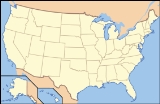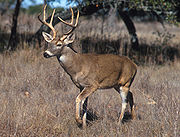
Valentine National Wildlife Refuge
Encyclopedia
Valentine National Wildlife Refuge is located in the U.S. state
of Nebraska
and includes 19,131 acres (77.42 km2). The refuge protects a portion of the largest remaining area of tall and mid grass prairie
remaining in the U.S. Collectively known as the sand hills
region of Nebraska, the dunes were the end result of the last ice age
known as the Pinedale glaciation. During the Holocene glacial retreat
the sand dunes that been deposited in their current location by the vast continental glaciers, were exposed and grasses eventually took over. The refuge is managed by the U.S. Fish and Wildlife Service and along with Fort Niobrara
and John and Louise Seier National Wildlife Refuge
s, they form the Fort Niobrara National Wildlife Refuge Complex.
 Numerous lakes and ponds are located on the refuge, fed by underground seeps and springs. 260 species of birds have been identified over the years on the refuge, and during migratory periods in the spring and fall, 150,000 birds pass through the protected area. White-tailed
Numerous lakes and ponds are located on the refuge, fed by underground seeps and springs. 260 species of birds have been identified over the years on the refuge, and during migratory periods in the spring and fall, 150,000 birds pass through the protected area. White-tailed
and Mule deer
are commonly found and muskrat
and beaver
inhabit the wetlands and streams.
Valentine NWR is located about 20 miles (32 km) south of Valentine, Nebraska
off U.S. Highway 83.
U.S. state
A U.S. state is any one of the 50 federated states of the United States of America that share sovereignty with the federal government. Because of this shared sovereignty, an American is a citizen both of the federal entity and of his or her state of domicile. Four states use the official title of...
of Nebraska
Nebraska
Nebraska is a state on the Great Plains of the Midwestern United States. The state's capital is Lincoln and its largest city is Omaha, on the Missouri River....
and includes 19,131 acres (77.42 km2). The refuge protects a portion of the largest remaining area of tall and mid grass prairie
Prairie
Prairies are considered part of the temperate grasslands, savannas, and shrublands biome by ecologists, based on similar temperate climates, moderate rainfall, and grasses, herbs, and shrubs, rather than trees, as the dominant vegetation type...
remaining in the U.S. Collectively known as the sand hills
Sand Hills (Nebraska)
The Sand Hills, often written Sandhills, is a region of mixed-grass prairie on grass-stabilized sand dunes in north-central Nebraska, covering just over one quarter of the state...
region of Nebraska, the dunes were the end result of the last ice age
Ice age
An ice age or, more precisely, glacial age, is a generic geological period of long-term reduction in the temperature of the Earth's surface and atmosphere, resulting in the presence or expansion of continental ice sheets, polar ice sheets and alpine glaciers...
known as the Pinedale glaciation. During the Holocene glacial retreat
Holocene glacial retreat
Holocene glacial retreat had a profound effect on landscapes in many areas that were covered by ice at the Last Glacial Maximum. The many valleys of the Cairngorms, a mountainous region in the Eastern Scottish Highlands are littered with deposits from this period.-Evidences of the retreat of the...
the sand dunes that been deposited in their current location by the vast continental glaciers, were exposed and grasses eventually took over. The refuge is managed by the U.S. Fish and Wildlife Service and along with Fort Niobrara
Fort Niobrara National Wildlife Refuge
Fort Niobrara National Wildlife Refuge is located in the U.S. state of Nebraska and includes 19,131 acres . The refuge borders the Niobrara National Scenic River on the west and is managed by the U.S. Fish and Wildlife Service. From 1879 to 1906, the Fort Niobrara Military Reservation was...
and John and Louise Seier National Wildlife Refuge
John and Louise Seier National Wildlife Refuge
John and Louise Seier National Wildlife Refuge is located in the U.S. state of Nebraska and includes 2,400 acres . The refuge protects a portion of the largest remaining area of tall and mid grass prairie remaining in the U.S. Collectively known as the Sand Hills region of Nebraska, the dunes...
s, they form the Fort Niobrara National Wildlife Refuge Complex.

White-tailed Deer
The white-tailed deer , also known as the Virginia deer or simply as the whitetail, is a medium-sized deer native to the United States , Canada, Mexico, Central America, and South America as far south as Peru...
and Mule deer
Mule Deer
The mule deer is a deer indigenous to western North America. The Mule Deer gets its name from its large mule-like ears. There are believed to be several subspecies, including the black-tailed deer...
are commonly found and muskrat
Muskrat
The muskrat , the only species in genus Ondatra, is a medium-sized semi-aquatic rodent native to North America, and introduced in parts of Europe, Asia, and South America. The muskrat is found in wetlands and is a very successful animal over a wide range of climates and habitats...
and beaver
Beaver
The beaver is a primarily nocturnal, large, semi-aquatic rodent. Castor includes two extant species, North American Beaver and Eurasian Beaver . Beavers are known for building dams, canals, and lodges . They are the second-largest rodent in the world...
inhabit the wetlands and streams.
Valentine NWR is located about 20 miles (32 km) south of Valentine, Nebraska
Valentine, Nebraska
-Demographics:As of the census of 2000, there were 2,820 people, 1,209 households, and 733 families residing in the city. The population density was 1,401.1 people per square mile . There were 1,373 housing units at an average density of 682.2 per square mile...
off U.S. Highway 83.

